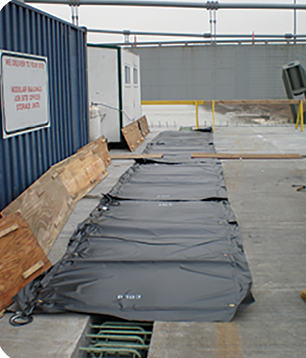
Although this Powerblanket is customized for an outdoor concrete cure, a similar design could be shaped for blade manufacturing or an on-the-turbine repair. For power figures, a blanket that wraps an entire 55-gal barrel runs off of 120V and consumes 720W.
A recent electric blanket design can provide sufficient heat to cure a two part epoxy in temperatures below those recommended by epoxy manufacturers. For the wind industry, the device makes it possible to repair a blade in cold temperatures or faster than previously possible on marginal days, and without removing the turbine rotor. Powerblankets, from Powerblanket, (www.powerblanket.com) are said to deliver even heat over every square inch of its customized surface.
Most epoxy resin and hardener combinations require heat to cure when ambient temperatures are too low. The chemical, mechanical, and heat-resistant properties are compromised when epoxy resins are not evenly or sufficiently heated. In fact, some epoxy resins require heating in steps to prevent overheating from exothermic reactions. Only when properly cured can epoxies become solid.
The company also provides custom heating designs that address freeze protection for a variety of applications. The blankets are available in multiple lengths and diameters and can be customized to fit any application. The devices provide heat to insulate and protect tanks, silos, and containers. Maximum freeze protection to -40°F.
The company adds that it provides custom-designed, electrically-heated blankets that can be placed over the epoxy seams of the leading and trailing edges of the blade in manufacturing settings, ensuring a proper cure.
When designed for specific applications, the blankets provide other features as well. For instance, cool epoxy resin and hardener are more difficult to meter and mix, so a heating device that fits the size and shape of the application maintains the best control possible. Warming the two components ensures they flow through dispensing pumps easily. Warm components also ensure more cross-linking.
The right heating solution also prevents air-bubbles and safeguards the strength and effectiveness of the epoxy. Lastly, the blankets prevent contamination by eliminating the use of kerosene or propane heaters, since these other methods can inhibit the curing process as well as contaminate epoxy surfaces. WPE
Filed Under: News





